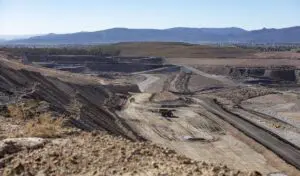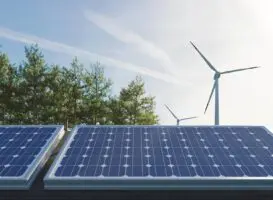Imagine nearly 6,000 dairy cows doing what cows do, belching and being flatulent for a full year. That’s how much methane was emitted from one Ohio reservoir in 2012.
Reservoirs and hydropower are often thought of as climate friendly because they don’t burn fossil fuels to produce electricity. But what if reservoirs that store water and produce electricity were among some of the world’s largest contributors of greenhouse gas emissions?

Scientists are searching for answers to that question, as they study how much methane is emitted into the atmosphere from man-made reservoirs built for hydropower and other purposes. Until recently, it was believed that about 20 percent of all man-made methane emissions come from the surface of reservoirs.
New research suggests that figure may be much higher than 20 percent, but it’s unclear how much higher because too little data is available to estimate. Methane is about 35 times as potent a greenhouse gas as carbon dioxide over the span of a century.
Think about man-made lakes in terms of cows passing gas: Harsha Lake, a large reservoir near Cincinnati, Ohio, emitted as much methane in 2012 as roughly 5,800 dairy cows would have emitted over an entire year, University of Cincinnati biogeochemist Amy Townsend-Small told Climate Central.

Methane emissions from livestock are the second-largest source of methane emissions in the U.S., behind crude oil and natural gas, according to the U.S. Environmental Protection Agency. But the EPA’s greenhouse gas emissions estimates do not yet account for methane emissions coming from man-made reservoirs.
Part of the reason is that, generally, very little is known about reservoirs and their emissions, especially in temperate regions, such as in the U.S., where few studies have been conducted.
In 2012 study, researchers in Singapore found that greenhouse gas emissions from hydropower reservoirs globally are likely greater than previously estimated, warning that “rapid hydropower development and increasing carbon emissions from hydroelectric reservoirs to the atmosphere should not be downplayed.”
Those researchers suggest all large reservoirs globally could emit up to 104 teragrams of methane annually. By comparison, NASA estimates that global methane emissions associated with burning fossil fuels totals between 80 and 120 teragrams annually.
But how much reservoirs contribute to global greenhouse gas emissions is “still a big question mark,” because the issue remains relatively unstudied and emission rates are highly uncertain, said John Harrison, an associate professor in the School of the Environment at the Washington State University-Vancouver whose research focuses on how reservoirs can be managed to reduce greenhouse gas emissions.
“So I don’t think we really know what the relative greenhouse gas effect of reservoirs is compared to other sources of energy in the U.S.,” he said.
Research at Harsha Lake may help scientists better understand how reservoirs contribute to climate change.
In a study published in August, Townsend-Small and researchers from the EPA found that Harsha Lake emitted more methane into the atmosphere in 2012 than had ever been recorded at any other reservoir in the U.S.
“When you compare the annual scale of the methane emission rate of this reservoir (Harsha Lake) to other studies, it’s really much higher than people would predict,” EPA research associate and Harsha Lake study lead author Jake Beaulieu told Climate Central.
Scientists have long thought reservoirs in warmer climates in the tropics emitted more methane than reservoirs in cooler climates, but the research at Harsha Lake shows that may not be the case, Townsend-Small said.
“We think this is because our reservoir is located in an agricultural area,” she said.
Methane is generated in reservoirs from bacteria living in oxygen-starved environments.
“These microbes eat organic carbon from plants for energy, just like people and other animals, but instead of breathing out carbon dioxide, they breathe out methane,” Townsend-Small said. “These same types of microbes live in the stomachs of cows and in landfills, which are other sources of methane to the atmosphere.”
Runoff from farmland around Harsha Lake provides more nutrients in the water, allowing algae to grow, just like numerous other reservoirs surrounded by agricultural land across the country.
Methane-generating microbes feed on decaying algae, which means that lakes catching a lot of nutrient-rich agricultural runoff generate a lot of methane.
“There are a very large number of these reservoirs in highly agricultural areas around the U.S.,” Townsend-Small said. “It could be that these agricultural reservoirs are a larger source of atmospheric methane than we had thought in the past.”
Emissions from reservoirs in all climates could be underestimatedbecause of a discovery Beaulieu’s team found at Harsha Lake: The area where a river enters a man-made lake emits more methane than the rest of the lake overall.
Nobody has measured that before, Beaulieu said.
Most other research studying reservoir methane emissions doesn’t account for how emissions may vary across the surface of a lake, he said.
The EPA is about to begin a more comprehensive study measuring methane emissions from 25 reservoirs in a region stretching from northern Indiana to northern Georgia, with sampling beginning next year, Beaulieu said.
That study will help the EPA eventually include reservoir methane emissions in its total estimates of human-caused methane emissions.
Until that and other studies are complete, scientists can only speculate on the impact hydropower is having on the climate.
“We’re still in the very early days here of understanding how these systems work with respect to greenhouse gas production,” Harrison said.
Source: Climate Central. Reproduced with permission.








